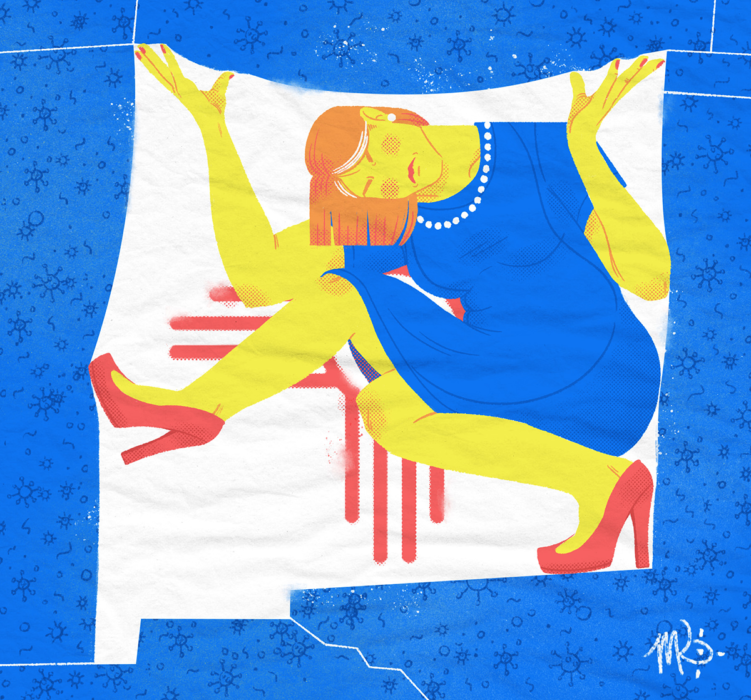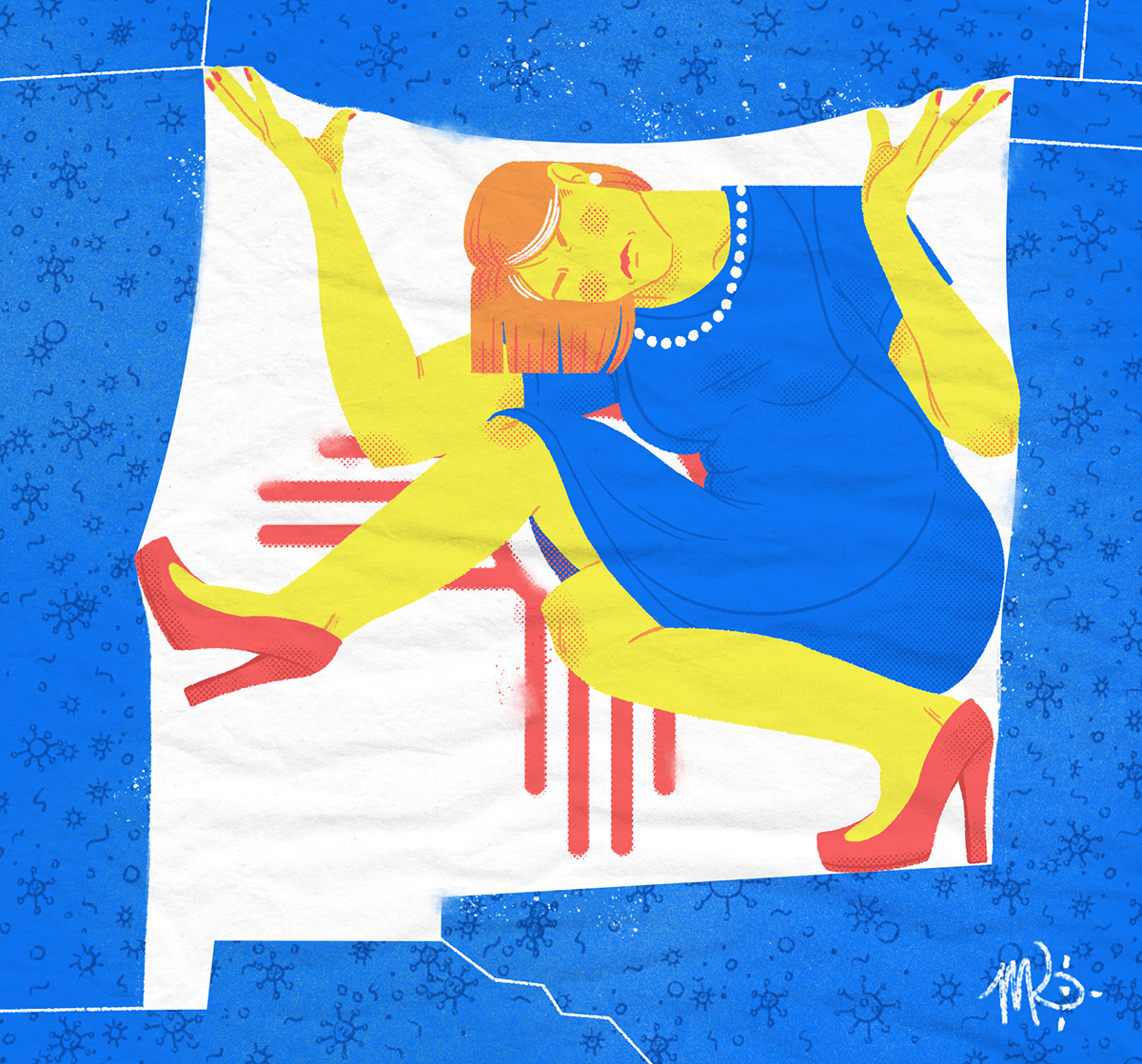
During a recent briefing, New Mexico Governor Michelle Lujan Grisham held up a picture of her mother, who lives in an assisted-living facility in Albuquerque. To reduce the odds of her mother contracting COVID-19, Lujan Grisham and her brother hadn’t visited her for six weeks. But other New Mexicans, she said, weren’t taking social distancing as seriously. An analysis of cell phone location data revealed that New Mexicans were spending a relatively liberal amount of time at grocery stores, gas stations, parks, and the like. Lujan Grisham said she was “disturbed” by folks defying the state’s stay-at-home order, and that their unnecessary travel puts vulnerable populations at risk.
“I could lose my mother,” she said during the live-streamed briefing. “I think about my mom every time I have to make a tough decision. … It’s all about saving lives.”
Read our previous coverage of the COVID-19 outbreak
Lujan Grisham, like all governors, has had a career’s worth of tough decisions to make in recent weeks. But the Democratic governor’s circumstances in New Mexico, a heavily rural state with a strong conservative streak, offer a valuable perspective on the challenges that await the West. When it does come time to lift stay-at-home orders, Lujan Grisham must contend with pressure from rural and conservative lawmakers eager to quickly re-open shuttered businesses. And any decision she makes will be complicated by the choices of those around her. Just as an individual’s callousness could put her mother at risk, the actions of neighboring states — in the absence of federal leadership — could derail even a carefully planned and executed coronavirus recovery.
“There is no on-off switch. It’s somewhat experimental,” said Bruce Perlman, director of the University of New Mexico’s public administration school. “What happens if you have a new outbreak? Are you then irresponsible? In some respects, the decision to take off social distancing is filled with as much, if not more, peril than the decision to put it on.”
Among governors in the Interior West, Lujan Grisham has been among the most aggressive at curbing the outbreak. Her stay-at-home order came on March 23, the same day as Oregon and Washington and before any New Mexicans had died of COVID-19. By comparison, 110 Washington residents had died at that point. Last week, when Lujan Grisham extended the order, she took the unusual step of closing payday loan businesses and liquor stores (even Utah’s liquor stores remain open). Her administration waived the one-week waiting period for folks to receive unemployment benefits, and boosted spending on food stamps.
Lujan Grisham has been out front on health measures, too — not surprising given she was the state’s health secretary from 2004 to 2007. New Mexico waived cost-sharing for patients receiving COVID-19 treatment, and it leads all Western states in the rate of testing. The state health department recently made public much of its COVID-19 data, a level of transparency eschewed by many states.
This story was funded by our readers.
Contribute today to support independent Western media.
“It appears to us she has acted very prudently,” said James Jimenez, executive director of New Mexico Voices for Children and former chief of staff for Governor Bill Richardson. “The number of deaths is still going up, the number of infections is still going up, but as a former health secretary, she has a better understanding of how a virus like this can spread itself amongst the population. Overall, I think she’s done a really good job.”
There are troubles. As of this writing, COVID-19 has killed 44 people in New Mexico and infected 1,597. The health department’s public database revealed an unnerving statistic: Native Americans make up more than two-thirds of the state’s cases, even though they account for just 11 percent of the population.
It’s figures like these, Jimenez said, that must dictate governors’ actions once the public health crisis abates. “Public policies going forward must be focused on the lessons learned from this pandemic: Our health care system has been shown to be somewhat inadequate. And the level of food insecurity in our state is appalling,” he said.
Governors today face a two-pronged issue: mitigating the present outbreak, and reopening society in a fashion that doesn’t send us tailspinning into another one. But across the West, state legislators — primarily Republicans — are hounding governors to lift shelter-in-place orders. “It is past time to rethink your response to COVID-19 as it pertains to the citizens of Montana and implement more strategic measures in an effort to re-engage our economy once again,” the leaders of Montana’s House and Senate wrote to Governor Steve Bullock. Former congressman Raúl Labrador, now the chair of Idaho’s Republican Party, mimicked President Donald Trump, saying “the cure cannot be worse than the disease” and calling on Idaho Governor Brad Little to lift stay-at-home restrictions. (Little extended the order the next day.)
Lujan Grisham is receiving similar pressure. Steve Pearce, who ran against Lujan Grisham in 2018 and is now the state GOP chair, held a teleconference last week arguing the state is unfairly punishing small business owners. And some Republicans are criticizing Lujan Grisham for not yet calling a special session to address the projected $2 billion shortfall in the state budget thanks to plunging oil prices.
“If the answer [to delaying a special session] is: ‘Let’s wait till Trump sends us money,’ that’s kind of a dereliction of duty,” House Minority Whip Rod Montoya told the Santa Fe New Mexican.
Lujan Grisham was not made available for an interview with Bitterroot, but spokesman Tripp Stelnicki said the administration has only just begun planning to lift social distancing restrictions. “Public health is the first and only consideration,” he said in an email.
When that decision comes, though, Lujan Grisham will have to strike a tender balance. “If you open too soon, you’ll see a resurgence in the infection,” she said during the briefing. “If you open too late, we’ll miss opportunities to save businesses, to provide economic security for families and individuals, and this state needs an economic response today and for the future.”
There’s a good chance she’ll be making those decisions alone. The governors of Washington, Oregon, and California have said they’ll coordinate their reopening efforts, and are already issuing initial criteria for such a process. There is no such agreement among states in the Southwest, however; neither Utah nor Texas have even adopted population-wide stay-at-home orders.
Both Perlman and Jimenez served alongside Lujan Grisham in the Richardson administration, and they expect the current governor to adhere to the advice of public health experts. The early decision to shutter businesses, Perlman said, wouldn’t have been an easy one to make. “I have hives just thinking about it,” he said. But the upcoming decisions may be even more challenging.
“It’s easier, if you will, to drop the reins than to pick them up,” Perlman said. “I think you don’t know what the right point is. And it may be a little bit of a dance — you have to open up, and then close down again. You have social distancing, then relax it, then go back for a little bit.”
Stelnicki said it’s premature for the governor’s office to be forming a concrete plan for such an uncertain situation. But Jimenez and Perlman said they expect Lujan Grisham to adopt a data-informed, graduated reopening of businesses. That might mean opening up businesses like golf courses first — it’s easy to socially distance on the fairway — and limiting restaurant capacity to 25, and then 50, percent.
In her latest press conference Wednesday, Lujan Grisham said the state is coordinating with the feds on screening in the Four Corners region, where many Navajo people have contracted COVID-19. Additionally, New Mexico will be part of a pilot program to ramp up testing and contact tracing. But even if those measures are realized quickly, the easing of restrictions likely won’t take place soon.
Critics upset with her pace will have little recourse. Lujan Grisham, like governors around the country, is utilizing post-9/11 emergency authorizations to stem the pandemic in the absence of federal directives. And, contrary to President Donald Trump’s assertions, the power to re-open sectors of the economy will remain with governors.
“We have a long way to go, New Mexico,” Lujan Grisham said during her briefing on Wednesday. “It was never going to be easy, but we are, in fact, saving lives.”

